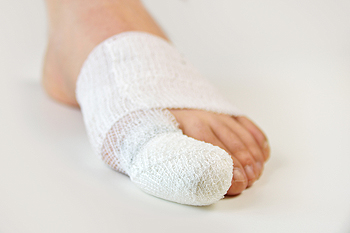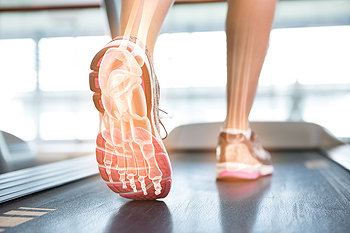
A stubbed toe is usually a minor injury that occurs when one suddenly hits or jams their toe. It can happen from kicking something hard, tripping, or catching the toe on an object. Pain that is felt after stubbing one’s toe typically subsides after a few minutes but in some cases, the pain can worsen as time goes on. The toes have lots of nerves and little to no fat cushioning, which can make this injury quite painful. Stubbing one’s toe can cause fractures, sprains, broken nails, and infections, and if one of these things happens, it can be more serious. There is a possibility the toe is broken if it is excessively painful to put weight on it after the injury. Similarly, if the toe and foot swell or appear discolored, if a bone is out of place or poking through the skin, or if one has trouble moving the toe, it may be broken. If you feel you have sustained more than a minor injury to your toe, it is suggested that you visit a podiatrist for proper diagnosis and treatment.
Toe pain can disrupt your daily activities. If you have any concerns, contact one of our podiatrists of Lewis Wolstein, DPM, P.C. & Associates. Our doctors can provide the care you need to keep you pain-free and on your feet.
What Causes Toe Pain?
Most severe toe pain is caused due to a sports injury, trauma from dropping something heavy on the toe, or bumping into something rigid. Other problems can develop over time for various reasons.
Toe pain can be caused by one or more ailments. The most common include:
- Trauma
- Sports injury
- Wearing shoes that are too tight
- Arthritis
- Gout
- Corns and calluses
- Hammertoe
- Bunions
- Blisters
- Ingrown toenails
- Sprains
- Fractures (broken bones)
- Dislocations
When to See a Podiatrist
- Severe pain
- Persistent pain that lasts more than a week
- Signs of infection
- Continued swelling
- Pain that prevents walking
Diagnosis
In many cases the cause of toe pain is obvious, but in others, a podiatrist may want to use more advanced methods to determine the problem. These can range from simple visual inspections and sensation tests to X-rays and MRI scans. Prior medical history, family medical history, and any recent physical traumatic events will all be taken into consideration for a proper diagnosis.
Treatment
Treatments for toe pain and injuries vary and may include shoe inserts, padding, taping, medicines, injections, and in some cases, surgery. If you believe that you have broken a toe, please see a podiatrist as soon as possible.
If you have any questions please feel free to contact our office located in Co-Op City, NY . We offer the newest diagnostic tools and technology to treat your foot and ankle needs.




